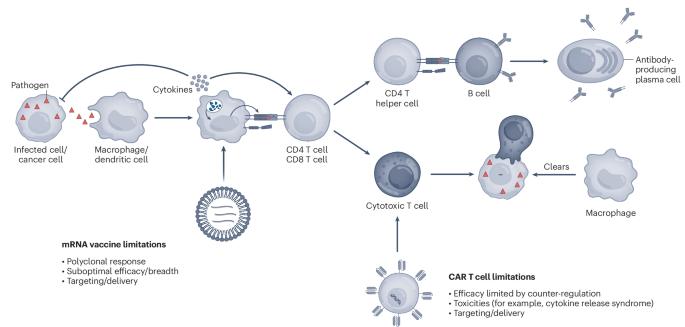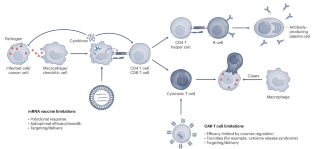Bottom-up synthetic immunology
IF 38.1
1区 材料科学
Q1 MATERIALS SCIENCE, MULTIDISCIPLINARY
引用次数: 0
Abstract
Infectious diseases and cancer evade immune surveillance using similar mechanisms. Targeting immune mechanisms using common strategies thus represents a promising avenue to improve prevention and treatment. Synthetic immunology can provide such strategies by applying engineering principles from synthetic biology to immunology. Synthetic biologists engineer cells by top-down genetic manipulation or bottom-up assembly from nanoscale building blocks. Recent successes in treating advanced tumours and diseases using genetically engineered immune cells highlight the power of the top-down synthetic immunology approach. However, genetic immune engineering is mostly limited to ex vivo applications and is subject to complex counter-regulation inherent to immune functions. Bottom-up synthetic biology can harness the rich nanotechnology toolbox to engineer molecular and cellular systems from scratch and equip them with desired functions. These are beginning to be tailored to perform targeted immune functions and should hence allow intervention strategies by rational design. In this Perspective we conceptualize bottom-up synthetic immunology as a new frontier field that uses nanotechnology for crucial innovations in therapy and the prevention of infectious diseases and cancer. This Perspective highlights bottom-up molecular engineering and modular nanobiotechnological approaches for developing effective immunotherapeutics and their potential in personalized medicine.


自下而上的合成免疫学。
传染病和癌症利用类似的机制逃避免疫监视。因此,利用共同的策略来瞄准免疫机制,是改善预防和治疗的一条大有可为的途径。通过将合成生物学的工程原理应用于免疫学,合成免疫学可以提供这样的策略。合成生物学家通过自上而下的遗传操作或自下而上的纳米级构件组装来改造细胞。最近在利用基因工程免疫细胞治疗晚期肿瘤和疾病方面取得的成功凸显了自上而下合成免疫学方法的威力。然而,基因免疫工程大多局限于体外应用,而且受到免疫功能固有的复杂反调节的影响。自下而上的合成生物学可以利用丰富的纳米技术工具箱,从零开始设计分子和细胞系统,并使其具备所需的功能。这些系统已开始被定制来执行有针对性的免疫功能,因此可以通过合理的设计采取干预策略。在本《视角》中,我们将自下而上的合成免疫学概念化为一个新的前沿领域,利用纳米技术在治疗和预防传染病和癌症方面进行重要的创新。
本文章由计算机程序翻译,如有差异,请以英文原文为准。
求助全文
约1分钟内获得全文
求助全文
来源期刊

Nature nanotechnology
工程技术-材料科学:综合
CiteScore
59.70
自引率
0.80%
发文量
196
审稿时长
4-8 weeks
期刊介绍:
Nature Nanotechnology is a prestigious journal that publishes high-quality papers in various areas of nanoscience and nanotechnology. The journal focuses on the design, characterization, and production of structures, devices, and systems that manipulate and control materials at atomic, molecular, and macromolecular scales. It encompasses both bottom-up and top-down approaches, as well as their combinations.
Furthermore, Nature Nanotechnology fosters the exchange of ideas among researchers from diverse disciplines such as chemistry, physics, material science, biomedical research, engineering, and more. It promotes collaboration at the forefront of this multidisciplinary field. The journal covers a wide range of topics, from fundamental research in physics, chemistry, and biology, including computational work and simulations, to the development of innovative devices and technologies for various industrial sectors such as information technology, medicine, manufacturing, high-performance materials, energy, and environmental technologies. It includes coverage of organic, inorganic, and hybrid materials.
 求助内容:
求助内容: 应助结果提醒方式:
应助结果提醒方式:


